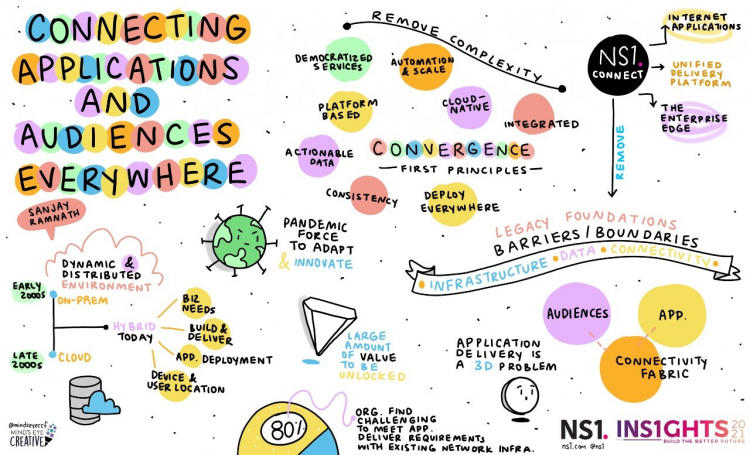Here at NS1, we’ve been on a journey since our founding to connect applications and audiences at a global scale, wherever they may be located. Our learnings in this area have become even more important as we move to a “digital first” world. Ensuring reliable and performant application delivery is now closely tied to business success across a growing number of industries.
Keep reading for key takeaways on:
The changes driving the urgency for digital transformation
What businesses often miss in digital transformation plans - and how it’s holding them back
Watch the Full Replay of this Session from INS1GHTS2021: Build the Better Future
Catch the full replay of Sanjay's keynote, as well as all the other great sessions from INS1GHTS2021, at our replay hub.
The Changes Driving the Urgency for Digital Transformation
While we operate in a dynamic, highly distributed networking environment today, it wasn’t that long ago that most application and network environments were highly centralized. For the most part, applications were deployed on-premises in central data centers. Within approximately a decade, we went from totally on-prem to fully in the cloud. Today, we’ve settled somewhere in the middle. We are maintaining legacy footprints, while still migrating some pieces to the cloud.
At the same time, other converging trends are putting even more pressure on your IT infrastructure:
Application architectures have become increasingly complex: they’ve evolved from monolithic application architectures to microservices-based architectures. We have multiple CDN environments. We have new practices, like DevOps, NetOps and SecOps, that have their own operational requirements as well.
Application deployment surfaces have changed: applications are now deployed on company-owned infrastructure, public cloud platforms, serverless environments, virtual environments, containerized deployments, and so on.
Audience and device footprint has also changed: You have your users spread out across centralized headquarters locations. So branch offices and remote locations. You have a largely mobile and remote workforce, a highly mobile and remote workforce. You have connected devices, edge networks, mobile devices, and so on and so forth.
And even more recently, the pandemic has accelerated innovation: chaos spurs innovation. The pandemic - and how it has changed the business and technology environment - is spurring organizations to innovate at a very rapid pace.
Because of these shifts, your IT infrastructure is now very closely coupled with business value. In response, companies are rushing towards digital transformation. Most, however, are focused on the “innovation surface”: new tools, new deployment platforms, new operating models like DevOps, etc. What’s really slowing down their digital transformation process is neglecting their legacy, foundational infrastructure; In fact, some studies show that over 80% of organizations cite it as a top challenge.

Why These Changes Complicate Digital Transformation
The reason why this is so challenging is because application delivery and application connectivity today is a three-dimensional problem:
Audiences have changed- Your users are everywhere. Your users are remote. Your devices are everywhere. Your devices are dispersed and distributed. Your networks are moving closer and closer to the edge, and need to bring compute and storage along with them.
Applications have changed - Applications are evolving as well, from the way they are developed, to the places they are deployed in a highly distributed and dynamic manner. The tools that are used to deploy and deliver them have also changed, along with the platforms and architectures on which they're deployed and delivered.
The connectivity fabric itself has changed - Today's connectivity fabric has to be extremely adaptable to a constantly changing environment. It must deliver on performance, availability, cost, global reach, geographical dispersion, multiple content delivery networks, custom routing requirements, and a very high demand for resiliency and uptime.
The conventional approach to solving this problem has been to piece together as many tools as possible, which results in a complex, fragmented ecosystem of solutions (i.e., different teams and different people using different tools for different workflows, different user interfaces, different technologies, different commercial models, and so on). This slows innovation by creating 3 main barriers:
Infrastructure boundaries, such as deploying across different application surfaces and vendors
Data boundaries, or making all the data across your complex environment both visible and actionable
Connectivity boundaries, or scaling globally with manual operations, while also optimizing for availability, performance and cost.
So how do we eliminate these barriers to innovation? Check out part two of the post: How NS1 Eliminates Boundaries in Your Foundational Infrastructure.
